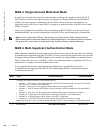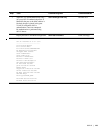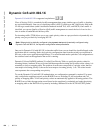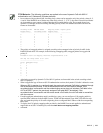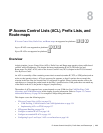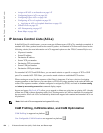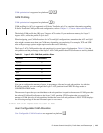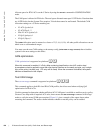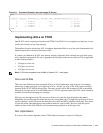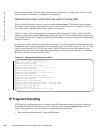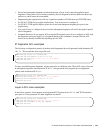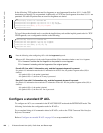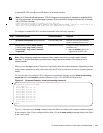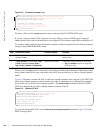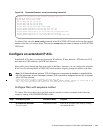136 | IP Access Control Lists (ACL), Prefix Lists, and Route-maps
www.dell.com | support.dell.com
Allocate space for IPV6 ACLs on the C-Series by using the cam-acl command in CONFIGURATION
mode.
The CAM space is allotted in FP blocks. The total space allocated must equal 13 FP blocks. Note that there
are 16 FP blocks, but the System Flow requires 3 blocks that cannot be reallocated. The default CAM
Allocation settings on a C-Series matching are:
• L3 ACL (ipv4acl): 6
• L2 ACL(l2acl) : 5
• IPv6 L3 ACL (ipv6acl): 0
• L3 QoS (ipv4qos): 1
• L2 QoS (l2qos): 1
The
ipv6acl allocation must be entered as a factor of 2 (2, 4, 6, 8, 10). All other profile allocations can use
either even or odd numbered ranges.
You must save the new CAM settings to the startup-config (
write-mem or copy run start) then reload the
system for the new settings to take effect.
CAM optimization
CAM optimization is supported on platforms c s
When this command is enabled, if a Policy Map containing classification rules (ACL and/or dscp/
ip-precedence rules) is applied to more than one physical interface on the same port-pipe, only a single
copy of the policy is written (only 1 FP entry will be used). When the command is disabled, the system
behaves as described in this chapter.
Test CAM Usage
The test cam-usage command is supported on platforms c e s
This command applies to both IPv4 and IPv6 CAM profiles, but is best used when verifying QoS
optimization for IPv6 ACLs.
Use this command to determine whether sufficient ACL CAM space is available to enable a service-policy.
Create a Class Map with all required ACL rules, then execute the
test cam-usage command in Privilege
mode to verify the actual CAM space required. Figure 8-1 gives a sample of the output shown when
executing the command. The status column indicates whether or not the policy can be enabled.



